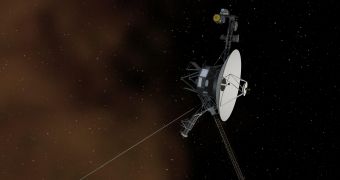NASA has made it official, the Voyager 1 probe has become the first human-made object to venture out into interstellar space. What this means is that Voyager 1 is no longer in an area dominated by the influence of the sun, but rather in the space between stars.
Signs of approaching interstellar space were first seen last year, but NASA has finally confirmed that the probe is out of the Solar System.
In fact, new measurements show that Voyager has been in interstellar space since August 2012, when many already speculating that the event had occurred.
"New and unexpected data indicate Voyager 1 has been traveling for about one year through plasma, or ionized gas, present in the space between stars. Voyager is in a transitional region immediately outside the solar bubble, where some effects from our sun are still evident," NASA announced.
The Voyager 1 probe has been traveling through space since 1977, making history along the way by being one of the first spacecraft to reach Jupiter, Saturn and beyond. Now, it has become the first human-made object to leave the Solar System.
The probe, which is powered by a nuclear reactor still has a few more years of life in it. NASA hopes Voyager 1 will continue to relay scientific information at least until 2020. Some estimates have it going a few years longer. However, even by powering down some equipment, eventually the reactor will fail to produce enough energy to power the probe.
Voyager 1 will then continue its journey in silence. The probe carries a golden record which contains photos as well as audio and video material from Earth, in the case some alien species encounters the craft.
The probe will remain the fastest and the farthest human-made object for the foreseeable future as the recently launched New Horizon probe will eventually be slower than Voyager 1, even if it launched with greater speed.
Voyager will pass by the star Gliese 445 in about 40,000 years at a distance of about 1.6 light-years, if it doesn't bump into anything until then or if future space-faring humans won't track it down and put it into a museum.

 14 DAY TRIAL //
14 DAY TRIAL //